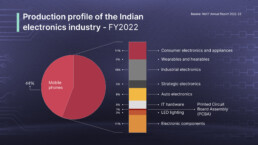From life-saving medical devices to autonomous vehicles, from space satellites to smart homes, electronics are the heartbeat of modern life. This digital revolution extends far beyond our personal devices, transforming industries like healthcare, automotive, telecommunications, aerospace, and manufacturing. As this technological wave reshapes every sector of the global economy, the race to build robust electronics manufacturing capabilities has intensified among nations. In this landscape, India is emerging as a powerful contender. This article explores how India is strategically positioning itself in the global electronics manufacturing ecosystem, building capabilities that will help shape the future of not just consumer technology, but entire industries and infrastructure systems that define modern civilization.
The Billion-Dollar ‘Circuit’: India’s electronics industry is booming
In the rapidly evolving global manufacturing landscape, India has emerged as a transformative player in the electronics industry, challenging traditional manufacturing powerhouses and carving out a strategic position in the global value chain.
The electronics manufacturing sector reflects India’s ambitions to become a self-reliant and technologically advanced nation. Supported by progressive government policies like the National Policy on Electronics (NPE), the Make in India initiative, and Production Linked Incentive (PLI) schemes, India has attracted investments and developed infrastructure to create an ecosystem conducive to manufacturing growth. In fact, PLI, which has become a rallying point for the government’s goal to turn India into a global export hub, incentivizes manufacturing across 14 sectors, including large-scale electronics. The result? In FY 2022, electronics manufacturing contributed approximately 2.7% to India’s GDP. By 2024, this figure had risen to around 3.4% and is projected to climb further, reaching 4.7% by FY 2026. Today, what was once predominantly an import-dependent market has now begun to position itself as a competitive global production centre, particularly in mobile phone manufacturing and electronic components.
Inside the Circuit: A look at the electronics industry’s core segments
India has showcased its manufacturing prowess across four major segments—mobile phones, consumer electronics, IT hardware, and electronic components. Together these account for over 70% of the country’s domestic manufacturing profile.
Mobile phones: India has emerged as the 2nd largest mobile handset manufacturer globally in terms of volume. The sector has grown from just 2 units in 2014 to over 200 units.
Consumer electronics: A cornerstone of India’s manufacturing strength, this segment encompasses a vast array of everyday products like televisions, cameras, audio devices, and home gadgets, fueling entertainment, recreation, and communication needs.
Information and Communications Technology (ICT) hardware: This sector holds immense potential for high-value addition. The good news is, with rising demand for connectivity—especially after the COVID-19 pandemic—India has already made significant strides in product design, semiconductor design, and manufacturing of ICT components.
Electronic components: Major sectors like mobile phones, consumer electronics, and industrial electronics drive 82% of the demand for components in India. Additional growth stems from computer hardware, strategic electronics, and lighting solutions.
Made in India: Exploring the growth drivers of India’s electronics manufacturing boom
India’s emergence as a global electronics manufacturing hub is driven by a confluence of factors, including rising domestic consumption fueled by digitization, strategic government initiatives, robust global partnerships, advanced manufacturing infrastructure, a skilled workforce, and the reconfiguration of global supply chains.
Unlocking Potential: Taking the digital leap
India, the world’s second-largest smartphone market, has seen mobile production grow fivefold from 2015 to 2022, driven by 5G adoption and rising affordability. Domestically, the expanding middle class, higher disposable incomes, and increased digital adoption have boosted demand for consumer electronics, projected to reach $21.18 billion by 2025. Infrastructure projects like smart cities and public Wi-Fi networks further contribute to this surge, creating opportunities for digital solutions.
From Policy to Production: Proactive government initiatives
Proactive government initiatives, strategic policies, and incentives have played a major role in driving India’s growth as a global electronics hub, by attracting investment, encouraging innovation, and promoting self-reliance in manufacturing.
Make in India & Digital India
While the Make in India initiative has propelled India’s manufacturing capabilities by fostering investment, innovation, and ease of doing business, Digital India has accelerated digital adoption, creating a robust demand for locally manufactured electronics and enabling the development of cutting-edge infrastructure. Together, they have positioned India as a global leader in electronics production.
The National Policy on Electronics (NPE)
India’s flagship electronics policy (NPE) has a clear goal: to transform the country into a world-class hub for Electronics System Design and Manufacturing (ESDM). Introduced in 2012 and revamped in 2019, the policy includes several specialized schemes that have successfully consolidated the foundations for a competitive Indian ESDM value chain. The Ministry of Electronics and Information Technology (Meity) plans to revise the comprehensive National Policy on Electronics 2019 (NPE 2019) to :meet the demand of the $500 Bn domestic electronics market by 2030. Besides creating Indian brands, the policy will focus on manufacturing electronics components and semiconductors. To support the development of such products and brands, the government is considering establishing a fund of funds and an intellectual property rights pool.
Schemes proposed under the NPE 2.0
- Modified Electronics Manufacturing Clusters (EMC 2.0): To provide financial assistance to create infrastructure and common facilities for electronics manufacturers
- Program for Development of Semiconductors and Display Manufacturing Ecosystem: To develop semiconductor and display manufacturing
- The NPE also aims to improve cyber security by promoting the use of secure chips and systems.
Production Linked Incentive (PLI) Scheme for large-scale electronics manufacturing
The PLI Scheme, introduced in 2020, has become a game-changer for domestic manufacturing. This innovative policy aims to boost domestic manufacturing and reduce the country’s reliance on imports. Targeting large-scale electronics manufacturing, the scheme provides incentives of 4–6% on incremental sales of manufactured goods. This incentive framework was designed to offset cost disabilities in the electronics sector, including high financing costs, expensive logistics, and inadequate infrastructure for power and water supply. The PLI scheme is expected to generate additional production worth INR 10,69, 432 crore and create employment opportunities for 7 lakh people. In 2023, the Ministry of Electronics and Information Technology (MeitY) notified PLI Scheme 2.0, which aims to strengthen the IT hardware manufacturing ecosystem in India, covering a range of devices. With ₹2,430 crore investment, PLI 2.0 is expected to generate 75,000 new jobs.
Production growth: From 5.8 crore units (2014-15) to 33 crore units (2023-24).
Import reduction: From 21 crore units (2014-15) to 0.3 crore units (2023-24).
Export surge: From ₹1,556 crore (2014-15) to ₹1.29 lakh crore (2023-24).
32 companies have been approved under PLI for large-scale manufacturing.
SPECS: The Scheme for Promotion of Manufacturing of Electronic Components and Semiconductors (SPECS) aims to boost India’s semiconductor and electronic components manufacturing capabilities. It offers 25% financial incentives on capital expenditure for key components in the electronics value chain.
India Semi-conductor Mission (ISM) is opening doors for manufacturers in semiconductors, display manufacturing and design ecosystem through financial support.
Modified Special Incentive Package Scheme (M-SIPS) promotes large scale manufacturing–a total of 314 companies in the electronics sector have been approved under M-SIPS with a proposed investment of INR 86,824 crore.
EDF: Fostering innovation is essential to ensure the growth and competitiveness of the electronics industry, driving technological advancements and addressing evolving market demands. This is where the Electronics Development Fund (EDF) plays a crucial role by creating an ecosystem for providing risk capital to the industry to undertake Research and Development (R&D) projects to ensure sustainable and cutting-edge advancements in India’s electronics industry.
Strengthening Manufacturing Infrastructure
A strong and efficient manufacturing infrastructure is vital for supporting industrial growth, enabling supply chain resilience, and attracting foreign investment. Not surprisingly, improving transportation networks is a priority for the government. There are over 9000 national infra projects in the pipeline with an outlay of 2 trillion USD. Leading this effort is the PM GatiShakti National Master Plan (PMGS-NMP), launched in 2021, for providing multimodal connectivity infrastructure to various economic zones. PM Gati Shakti will address roads, railways, airports, ports, mass transport, waterways and logistic infrastructure.
EMCs: Manufacturing clusters have proven to be a catalyst for industrial growth, offering companies access to shared resources, reduced logistics costs, and improved operational efficiencies. Vietnam’s remarkable rise as a global manufacturing hub is a testament to strategic planning and the robust execution of manufacturing clusters. Vietnam offers a unique combination of several key advantages to investors—these include low labor costs, strategic location on major trade routes, and well-developed specialized industrial zones and manufacturing clusters across the country. As a result, Vietnam’s exports have leapt nearly nine times that of India’s in the last decade, (Source: Indian Council for Research on International Economic Relations [ICRIER]).
Taking a leaf out of Vietnam’s book, India has created 19 Greenfield Electronics Manufacturing Clusters (EMCs) and 3 Common Facility Centres (CFCs) (as of August 2023). The government is also working on Dedicated Freight Corridors (DFCs) and Industrial Corridor (IC) to strengthen India’s industrial and logistical ecosystem.
Empowering the next gen with skills
By 2027-28, the electronics sector in India will employ 12 million people in direct and indirect jobs. However, the sector is projected to face a substantial workforce shortfall. Harnessing India’s demographic dividend and equipping the youth with advanced skills are crucial for maximizing the potential of the country’s emerging workforce.
Recognizing this urgent need, the Electronics Sector Skill Council (ESSC) aims to design a national curriculum tailored for emerging job roles in electronics. ESSC also works to improve the quality of skill training centers and promote vocational education across the country.
As of 2022, over 1.6 million candidates have been trained in diverse fields, from semiconductor components and consumer electronics to IT hardware, solar and LED, etc. In addition to ESSC, nationwide programs like Pradhan Mantri Kaushal Vikas Yojana (PMKVY) are further enhancing skill development by offering certification courses in multiple sectors.
Strategic Global Partnerships
The increasingly interconnected nature of the world we live in calls for collaboration, shared expertise, and pooling of resources across borders to achieve sustainable and impactful solutions. Success stories of East Asian economies such as Hong Kong (expected to hit $394 billion by 2024); Taiwan ($784 billion), and South Korea ($1756 billion) also show that “first globalise then localise” in the case of the electronics sector has worked better, according to an analysis by ICRIER.
Country Collaborations: The government’s comprehensive reforms have created a robust foundation that appeals to international electronics manufacturers seeking reliable alternatives in their global supply chains. As a result, India has fostered strong partnerships with South Korea, Japan, and Taiwan to bolster its semiconductor manufacturing capabilities. While India’s partnership with Japan focuses on building a semiconductor supply chain, Taiwanese companies like Foxconn are pivotal in developing India’s electronics manufacturing and semiconductor sectors.
Investment from Tech Giants: India’s growing market demand for electronics, technological capabilities, and a focus on improving ease of doing business further make it an attractive destination for global tech giants. Major global companies like Apple, Samsung, and Xiaomi are significantly ramping up their investments in India. Apple, for instance, now sources about one in seven iPhones from India, doubling its previous share in 2023, with $14 billion worth of iPhones assembled in India during FY2024. Samsung has established one of its largest mobile manufacturing plants in Noida, marking India’s growing significance in global supply chains. New Memorandums of Understanding (MoUs) are paving the way for local production, such as HP laptops, desktops, and all-in-one PCs by Padget in Chennai, expected to generate 1,500 jobs.
Global Uncertainties
Global supply chains have undergone a seismic shift in recent years, driven by pandemic disruptions, geopolitical tensions, and even catastrophic events due to climate-change. These challenges exposed vulnerabilities in over-reliant systems, prompting businesses to diversify. Consequently, India has emerged as a key player, leveraging its labor pool, infrastructure, and policies to position itself as a reliable alternative.
Smart Tech and Sustainable Growth: India’s electronics manufacturing takes flight
India’s electronics manufacturing sector is witnessing rapid growth driven by several emerging trends.
Wearables: The wearables market has seen exponential demand due to increased health consciousness and the growing preference for connected devices.
Auto electronics: According to Allied Market Research, the global automotive electronics market is projected to reach $382.16 billion by 2026, growing at a compound annual growth rate (CAGR) of 7.3% from 2019 to 2026. India’s emphasis on EV production, along with government incentives, positions it as a strong player in the auto electronics domain.
Industry 4.0 and smart operations: The shift towards smart factories enables real-time interaction between machines, systems, and humans, leading to enhanced efficiency, reduced waste, and optimized resource usage.
Samarth Udyog Bharat 4.0 initiative focuses on making Indian industries globally competitive by balancing high automation with cost-efficient, human-empowered smart technologies.
Wired for Growth: Roadblocks in India’s electronics industry
Despite recent growth, India’s electronics market accounts for only 3.3% of the global share, primarily concentrated in assembly rather than design and component manufacturing. The country still lags in developing indigenous design capabilities, which limits its competitiveness in the global market.
Supply chain vulnerabilities
India’s heavy reliance on imports for over 60% of its electronic components and semiconductors leaves the industry vulnerable to supply chain disruptions and price fluctuations. Dependencies on countries like China, Taiwan, and South Korea for key electronic parts can disrupt manufacturing processes during global supply chain crises.
Limited integration into global value chains
While India has made significant strides, its role in global electronics production networks still has room to grow compared to leading countries like China, South Korea, and Germany. India has not yet fully integrated into GVCs, particularly in the high-tech electronics sector. NITI Aayog’s “Powering India’s Participation in Global Value Chains” project is a step toward improving India’s position in these global networks.
High manufacturing costs
High manufacturing costs, remain a significant challenge for India’s electronics industry. This makes Indian-made electronics less competitive compared to products manufactured in countries with lower operational costs, like China. Currently, high logistics costs remain one of the major disadvantages for component manufacturers to consider India as a possible alternative manufacturing. The other major challenge for component manufacturers is the availability of quality raw material required to manufacture precision components such as PCBs and semiconductor fabrication units or fabs.
Regulatory framework and compliance
The complex and evolving regulatory framework in India can act as a barrier to seamless operations in the electronics sector. Manufacturers often face delays due to compliance requirements, licensing issues, and varying regulations across states.
Infrastructural deficiencies
Inadequate infrastructure, including inconsistent power supply, poor road connectivity, and limited logistics capabilities, can act as a hindrance in electronics manufacturing.
Accelerating towards 3030
As India charges forward in its quest to become a global electronics manufacturing leader, the country is setting its sights on an ambitious vision for 2030. With targets of $500 billion in electronics production and $200-225 billion in exports, India is not just shaping the future of its economy but also creating millions of employment opportunities in the process.
By 2025 alone, the industry is expected to generate over 1 million new jobs, significantly boosting its contribution to India’s GDP. While a few challenges persist, India’s young and talented demographic, focus on innovation, and government support will pave the way for sustained growth. The race is on, and India is accelerating towards the finish line.


